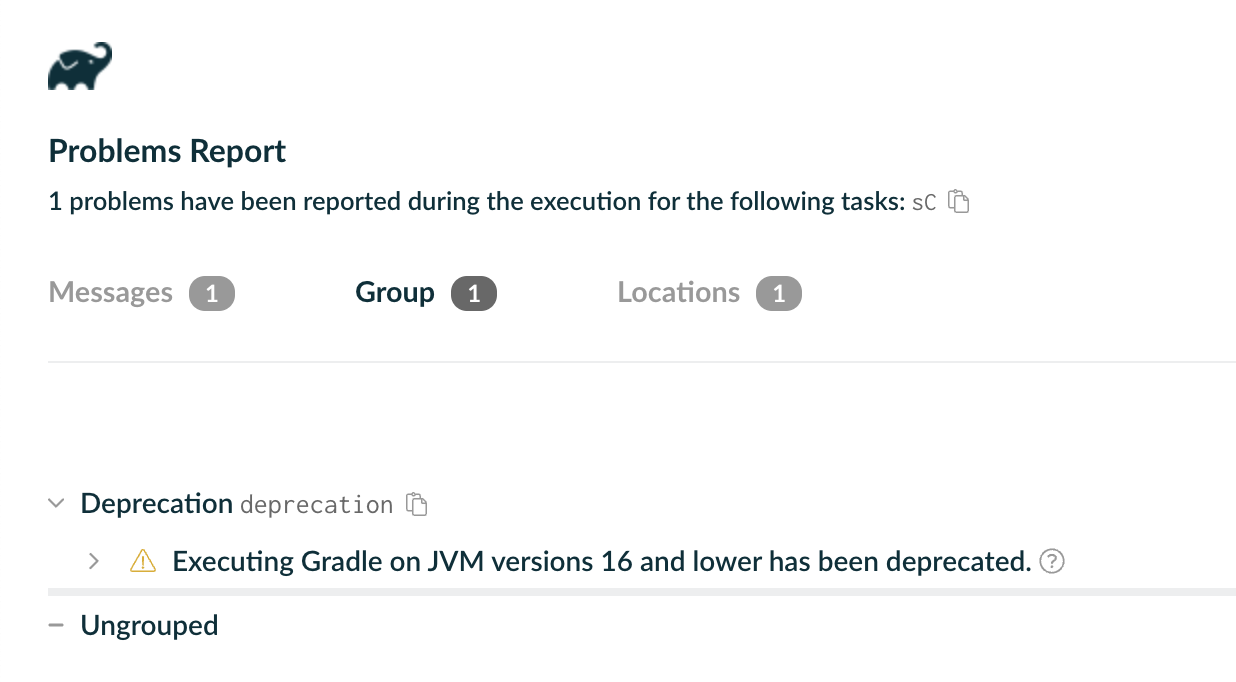插件可以通过 Gradle 的问题报告 API 报告问题。这些 API 报告构建过程中发生的丰富、结构化的问题信息。这些信息可以被不同的用户界面使用,例如 Gradle 的控制台输出、Build Scan 或 IDE,以最适当的方式向用户传达问题。
以下示例显示了从插件报告的问题
public class ProblemReportingPlugin implements Plugin<Project> {
public static final ProblemGroup PROBLEM_GROUP = ProblemGroup.create("sample-group", "Sample Group");
private final ProblemReporter problemReporter;
interface SomeData extends AdditionalData {
void setName(String name);
String getName();
}
@Inject
public ProblemReportingPlugin(Problems problems) { (1)
this.problemReporter = problems.getReporter(); (2)
}
public void apply(Project project) {
ProblemId problemId = ProblemId.create("adhoc-deprecation", "Plugin 'x' is deprecated", PROBLEM_GROUP);
this.problemReporter.report(problemId, builder -> builder (3)
.details("The plugin 'x' is deprecated since version 2.5")
.solution("Please use plugin 'y'")
.severity(Severity.WARNING)
.additionalData(SomeData.class, additionalData -> {
additionalData.setName("Some name"); (4)
})
);
}
}| 1 | Problem 服务被注入到插件中。 |
| 2 | 为插件创建了一个问题报告器。虽然命名空间由插件作者决定,但建议使用插件 ID。 |
| 3 | 报告了一个问题。此问题是可恢复的,因此构建将继续。 |
| 4 | 添加了一些额外数据。 |
有关完整示例,请参阅我们的端到端示例。
构建问题
报告问题时,可以提供各种信息。ProblemSpec 描述了所有可提供的信息。
问题汇总
在报告问题时,Gradle 确保报告简洁且没有不必要的冗余。具体来说,一旦达到某个阈值,它会阻止重复报告相同的问题。
-
在构建期间,问题的最初几个实例将作为问题报告,提供该问题的所有可用信息。
-
在构建结束时,相同问题的后续出现会被分组并汇总为问题摘要。此摘要与ProblemSummariesEvent一起提供,其中提供了总出现次数。
构建失败
指示构建失败的标准方法是抛出异常。ProblemReporter 通过允许抛出带有相关问题报告的异常来提供增强支持。
ProblemId id = ProblemId.create("sample-error", "Sample Error", StandardPlugin.PROBLEM_GROUP);
throw getProblems().getReporter().throwing((new RuntimeException("Message from runtime exception")), id, problemSpec -> {
problemSpec.contextualLabel("This happened because ProblemReporter.throwing() was called")
.details("This is a demonstration of how to add\ndetailed information to a build failure")
.documentedAt("https://example.com/docs")
.solution("Remove the Problems.throwing() method call from the task action");
});这确保了构建失败与底层问题明确关联,并且这些问题得到适当传达给各种客户端。当使用 Problems API 报告构建失败时,所有客户端(Tooling API、CLI、Build Scan 等)都将可以访问该关联。
命令行界面
CLI 构建失败输出将包含有关问题的详细信息。错误消息和描述直接来自问题报告。如果问题报告包含解决方案或建议的操作,这些将显示在通用解决方案的位置。
AdditionalData 不包含在 CLI 输出中。
FAILURE: Build failed with an exception.
* What went wrong:
Execution failed for task ':sample-project:myFailingTask'.
> Message from runtime exception
This happened because ProblemReporter.throwing() was called
This is a demonstration of how to add
detailed information to a build failure
* Try:
> Remove the Problems.throwing() method call from the task action
> Run with --scan to generate a Build Scan (Powered by Develocity).
BUILD FAILED in 0msTooling API 客户端
Tooling API 客户端可以通过根构建操作上的 Failure 对象访问与构建失败相关的详细问题报告。要接收这些报告,客户端必须为 OperationType.ROOT 操作类型注册一个进度侦听器。然后,进度侦听器回调应检查操作结果是否为 FailureResult 类型,然后可以通过 Failure.getProblems() 访问相关问题。
此外,还有一种更方便的方式来访问失败详情。如果客户端使用 LongRunningOperation.withFailureDetails() 配置项目连接,Tooling API 会隐式订阅 ROOT 操作类型,并通过 GradleConnectionException.getFailures() 方法提供失败详情。
生成的 HTML 报告
由 Problems API 生成的问题输出也作为在构建结束时生成的丰富的 HTML 报告提供。此报告作为用户查看构建期间发生问题的中心位置。
插件作者可以使用 Problems API 记录特定于其插件的事件,添加到 Gradle 生成的事件中。
AdditionalData 不包含在 HTML 报告中。
如果未报告任何问题,则不会生成报告。此外,如果您不想生成此报告,可以使用 --no-problems-report 标志禁用它。控制台输出提供了此报告的链接,如下所示
[Incubating] Problem report is available at: <project-dir>/build/reports/problems/problems-report.html
BUILD SUCCESSFUL in 1s渲染的报告链接将您定向到问题的详细 HTML 视图
